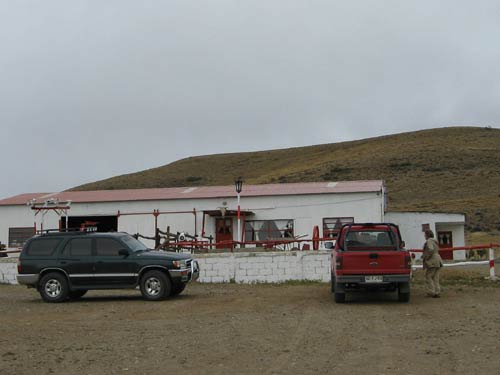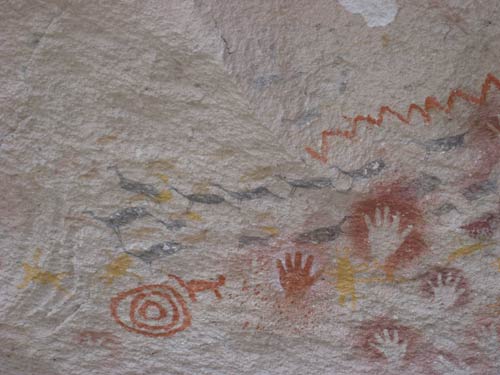

We left Chalten, having filled up with petrol. The next stretch up the Route 40 is devoid of people, animals, houses, petrol stations. 400 kms of unmitigated dirt road, with a loose skiddy surface. You have to hope you don't break down, as you are lucky if you see another car in each two hours driving. We did find one estancia serving food and coffee, which was a welcome chance to stretch our legs, then back on the dirt heading north.
Cueva de las Manos has been listed as a World Heritage Site since 1999. The UNESCO citation says "The Cueva de las Manos, Río Pinturas, contains an exceptional assemblage of cave art, executed between 13,000 and 9,500 years ago. It takes its name (Cave of the Hands) from the stencilled outlines of human hands in the cave, but there are also many depictions of animals, such as guanacos (Lama guanicoe), still commonly found in the region, as well as hunting scenes. The people responsible for the paintings may have been the ancestors of the historic hunter-gatherer communities of Patagonia found by European settlers in the 19th century."
Cueva de las Manos (Spanish for Cave of the Hands) is a cave 163 km south of the town of Perito Moreno. The Cave lies in an isolated spot in the Patagonian landscape, some 100 km from the main National Route 40. So you really want to have to want to seeit. It is a dead end road, and there are no hotels in the area, so the only option is to drive there and back. The site itself is well preserved, and the rangers give tours every hour. You cannot enter the site without waiting for a conducted ranger tour. A tour takes around an hour, and shows you all you need to see of the site.
The cave is named after the paintings of hands, made by the original inhabitants some 9,000 years ago. The the inks used are mineral, so the age of the paintings was calculated from the remains of bone-made pipes used for spraying the paint on the wall. The main cave has an entrance 15 m wide, and it is initially 10 m high. It is 24 m deep and , follows an upward slope inside, narrowing to 2 m at its end.
Most of the hands are left hands, which suggests that painters held the spraying pipe with their right hand, in order to do a better job. The size of the hands appear to indicate teen or pre-teen boys, which could indicate a initiation to manhood ritual, but in reality nobody knows why this was done.
The images of hands a mix of sprayed and stencilled, that is both positive and negative impressions. There are also drawings of human beings plus animals such as guanacos and rheas, as well as geometric shapes and hunting scenes. Small numbers of these paintings are also in neighbouring caves. The colours of the paintings range from red (made from hematite) to white, black or yellow. The negative hand impressions are calculated to be dated around 550 BC, the positive impressions from 180 BC, and the hunting drawings to be older than 9,000 years
 |
 |
| The only habitation between Chalten and Cueva de los Manos turn off | The valley near Cueva de las Manos |
 |
 |
| Entering Cueva de las Manos site with ranger | La Cueva de los Manos, Argentina |
 |
 |
| La Cueva de los Manos | La Cueva de los Manos, rock paintings |
 |
 |
| La Cueva de los Manos, rock paintings | La Cueva de los Manos, rock paintings |
 |
|
| We enjoyed it |